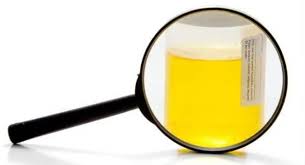
Most of us may have already given a urine sample at some point in our lives. Have you ever wondered why health professionals ask for a urine sample?
The urine can contain many different clues to how our body is doing. It tells a lot about our health. Testing the urine is known as “urinalysis” (analysis of the urine). The most common use of urinalysis is to detect substances or cells in the urine that point to different disorders.
The kidneys make urine by filtering wastes and extra water from the blood. The waste is called urea. The blood carries it to the kidneys. From the kidneys, urine travels down two thin tubes called ureters to the bladder. The bladder stores urine until we are ready to urinate. It swells into a round shape when it is full and gets smaller when empty. If the urinary system is healthy, the bladder can hold up to 16 ounces (2 cups) of urine comfortably for 2 to 5 hours.
What do the characteristics of urine tell us?
The elimination of urine is very important for different bodily functions. It regulates the balance of water in the body, for example, and also gets rid of substances that are produced during metabolic processes and are no longer needed by the body. These include toxic substances in food or medicines. Urine tests can help detect diseases of the urinary system as well as metabolic diseases like diabetes or liver disease.
The color, odor and amount of urine can already indicate whether something is wrong. If, for instance, someone passes only a little very dark urine, it could be a sign that they have not had enough to drink – or that their kidneys are no longer working properly. Cloudy or flaky urine could be a sign of a urinary tract infection. If the urine is reddish in color, there might be blood in it. To find out more, the urine needs to be tested using a urine test strip or in a lab.
Urine Color
Normal urine color varies, depending on how much water you drink. Fluids dilute the yellow pigments in urine, so the more you drink, the clearer your urine looks. When you drink less, the color becomes more concentrated. Severe dehydration can produce urine the color of amber.
But urine can turn colors far beyond what's normal, including red, blue, green, dark brown and cloudy white.
1. Pink urine
Despite its alarming appearance, red urine isn't necessarily serious. Red or pink urine can be caused by:
- Blood - Factors that can cause urinary blood (hematuria) include urinary tract infections, an enlarged prostate, cancerous and noncancerous tumors, kidney cysts, long-distance running, and kidney or bladder stones.
- Foods - Beets, blackberries and rhubarb can turn urine red or pink.
- Medications - Rifampin (Rifadin, Rimactane), an antibiotic often used to treat tuberculosis, can turn urine reddish orange — as can phenazopyridine (Pyridium), a drug that numbs urinary tract discomfort, and laxatives containing senna.
2. Orange urine
Orange urine can result from:
- Medications - Medications that can turn urine orange include the anti-inflammatory drug sulfasalazine (Azulfidine); phenazopyridine (Pyridium); some laxatives; and certain chemotherapy drugs.
- Medical conditions - In some cases, orange urine can indicate a problem with your liver or bile duct, especially if you also have light-colored stools. Dehydration, which can concentrate your urine and make it much deeper in color, can also make your urine appear orange.
3. Blue Urine / Green urine
Blue or green urine can be caused by:
- Dyes - Some brightly colored food dyes can cause green urine. Dyes used for some tests of kidney and bladder function can turn urine blue.
- Medications - A number of medications produce blue or green urine, including amitriptyline, indomethacin (Indocin, Tivorbex) and propofol (Diprivan).
- Medical conditions - Familial benign hypercalcemia, a rare inherited disorder, is sometimes called blue diaper syndrome because children with the disorder have blue urine. Green urine sometimes occurs during urinary tract infections caused by pseudomonas bacteria.
4. Dark brown Urine or Cola-colored urine
Brown urine can result from:
- Food - Eating large amounts of fava beans, rhubarb or aloe can cause dark brown urine.
- Medications - A number of drugs can darken urine, including the antimalarial drugs chloroquine and primaquine, the antibiotics metronidazole (Flagyl) and nitrofurantoin (Furadantin), laxatives containing cascara or senna, and methocarbamol — a muscle relaxant.
- Medical conditions - Some liver and kidney disorders and some urinary tract infections can turn urine dark brown.
- Extreme exercise - Muscle injury from extreme exercise can result in pink or cola-colored urine and kidney damage.
5. Murky urine
Urinary tract infections and kidney stones can cause urine to appear cloudy or murky.
Some also use dipsticks for urine testing or commonly known as UTI test strips. The colors indicated in these test strips are compared to a color chart which could help you determine if your pee is normal or a cause for alarm. Though it’s always best to go to a professional for diagnosis, it would also help to monitor once in a while for self-awareness.
What is a Dipstick or Test Strip Urinalysis?
A urinalysis is a urine test best performed on a full bladder first thing in the morning. A urinalysis checks appearance, concentration and content of urine and is used to detect and/or manage a wide range of medical disorders, such as urinary tract infections (UTI's), kidney disease and diabetes. A dipstick or urine test strip, usually a thin, plastic stick with strips of chemicals on it, is coated with urine, the chemical strips will change color if certain substances are present or if certain levels are above, or below, normal which can indicate the presence of compounds like proteins, ketones, hemoglobin, and nitrites, as well as harmful pathogens. Dipstick urinalysis is convenient, but false-positive and false-negative results can occur.
No preparation other than cleansing the area around the urethra (urinary opening) is required for the automated dipstick urinalysis.
When to see a doctor
Make an appointment with your doctor if you're urinating more frequently than usual and if:
- There's no apparent cause, such as drinking more total fluids, alcohol or caffeine
- The problem disrupts your sleep or everyday activities
- You have other urinary problems or worrisome symptoms
Contact your doctor as soon as possible if you have frequent urination along with any of these signs or symptoms:
- Blood in your urine
- Red or dark brown urine
- Painful urination
- Pain in your side, lower abdomen or groin
- Difficulty urinating or emptying your bladder
- A strong urge to urinate
- Loss of bladder control
- Fever
Urinary tract disorders may cause the above signs or symptoms, but so can other serious diseases or health conditions. Seek medical help to find out what's causing your frequent urination and how to treat it.
At home, you can also self-monitor your pee through a 10 Parameter Test Strip. This can be bought without prescription in your nearest drugstore or online. These dipsticks for urine not only indicate infection on our urinary tract but some other unhealthy conditions as well such as diabetes, kidney and liver disorders etc. However, we still recommend seeing a healthcare expert especially if above symptoms are showing.
Conclusion:
The urine tells a lot about your health. Throughout your life, you will likely experience at least one type of urinary system disorder. One good thing about it is that we can self-monitor at home and there are also a variety of successful treatments and medications. But, it is always best to prevent and be self-aware of what we eat and do. The urinary system is indeed an impressive machine working 24/7 in our body. We need to take all precautions to assure that it will always work well.
References:
- https://medlineplus.gov/urineandurination.html
- https://www.kidney.org/news/kidneyCare/spring10/UrineSamples
- https://www.ncbi.nlm.nih.gov/books/NBK279350/
- https://www.mayoclinic.org/diseases-conditions/urine-color/symptoms-causes/syc-20367333
- https://www.mayoclinic.org/symptoms/frequent-urination/basics/when-to-see-doctor/sym-20050712
- https://www.disabled-world.com/calculators-charts/urinalysis.php
- https://www.webmd.com/urinary-incontinence-oab/truth-about-urine
- https://www.byramhealthcare.com/blogs/everything-you-should-know-about-the-urinary-system






